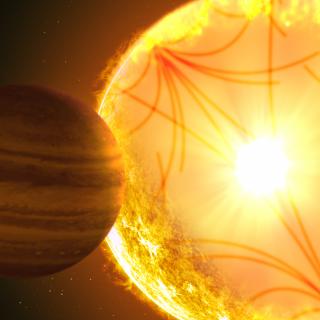Bibcode
Gourvès, C.; Breton, S. N.; Dyrek, A.; Lanza, A. F.; García, R. A.; Mathur, S.; Santos, Â. R. G.; Strugarek, A.
Referencia bibliográfica
Astronomy and Astrophysics
Fecha de publicación:
7
2025
Revista
Número de citas
2
Número de citas referidas
0
Descripción
Previous studies showed evidence of a dearth of close-in exoplanets around fast rotators, which can be explained by the combined action of intense tidal and magnetic interactions between planets and their host star. Detecting more exoplanets experiencing such interactions, with orbits evolving on short timescales, is therefore crucial to improve our understanding of the underlying physical mechanisms. For this purpose, we performed a new search for close-in non-transiting substellar companions in the Kepler data, focusing on orbital periods below 2.3 days. We focused on main-sequence solar-type stars and subgiant stars for which a surface rotation period was measured. For each star, we looked for an excess in the power spectral density of the light curve, which could correspond to the signature of a close-in non-transiting companion. We compared our candidates with existing catalogues to eliminate potential contaminants in our sample, and we visually inspected the phase-folded light curve and its wavelet decomposition. We identify 88 stars exhibiting a signature consistent with the presence of a close non-transiting substellar companion. We show that the objects in our sample are located mostly within the dearth zone, emphasising the importance of performing follow-up of such systems in order to gather observational evidence of star-planet interactions.
Proyectos relacionados

Sismología Solar y Estelar y Búsqueda de Exoplanetas
Los objetivos genéricos de este Proyecto son: 1) el estudio de la estructura y dinámica del interior solar, 2) la extensión de dicho estudio al caso de otras estrellas, 3) la búsqueda y caracterización de planetas extrasolares por métodos fotométricos (principalmente mediante el método de tránsitos) y espectroscópico (variaciones en la velocidad
Savita
Mathur